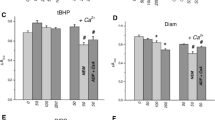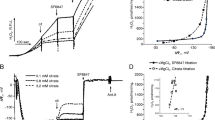Abstract
Fluorescein mercuric acetate (FMA) has been shown to be a potent inhibitor of energized processes in both beef heart mitochondria and ETPH particles. FMA reacts preferentially with a small number of specific sulfur atoms and inhibits the phosphate-dependent configurational transition. FMA enhances the anaerobic to aerobic pH changes observed in intact mitochondria and submitochondrial particles, and also enhances nonenergized swelling in 0·15 M sodium or potassium chloride. The results are interpreted in terms of a model whereby FMA, in reacting with the mitochondrion, modifies its conformation. The resulting conformational changes which occur upon energization are therefore different from those conformational changes which would occur in the absence of FMA. The net result of this process is the inhibition of some processes (e.g., oxidative phosphorylation, ATP-32Pi exchange, etc.) and the enhancement of other processes (the proton shift and nonenergized swelling in chloride salts).
Similar content being viewed by others
References
M. J. Lee, R. A. Harris, and D. E. Green,Biochem. Biophys. Res. Communs.,36, 937 (1969).
F. L. Crane, J. L. Glenn, and D. E. Green,Biochim. Biophys. Acta,22, 475 (1956).
Y. Hatefi and R. L. Lester,Biochim. Biophys. Acta,27, 83 (1958).
M. Hansen and A. L. Smith,Biochim. Biophys. Acta,81, 214 (1964).
A. G. Gornall, C. H. Bardawill, and M. M. David,J. Biol. Chem.,177, 751 (1949).
O. Lindberg and L. Ernster, in:Methods of Biochemical Analysis, Vol. III, D. Glick (ed.), Wiley, Interscience, New York, 1956, p. 1.
D. H. MacLennan, G. Lenaz, and L. Szarkowski,J. Biol. Chem.,241, (22); 5251 (1966).
J. B. Martin and D. M. Doty,Analyt. Chem.,21, 965 (1949).
J. T. Penniston, H. Vande Zande, and D. E. Green,Arch. Biochem. Biophys.,113, 507 (1966).
R. A. Harris, M. A. Asbell, J. Asai, W. W. Jolly, and D. E. Green,Arch. Biochem. Biophys.,132, 545 (1969).
R. A. Harris, M. A. Asbell, and D. E. Green,Arch. Biochem. Biophys.,131, 316 (1969).
D. W. Allmann, T. Wakabayashi, E. F. Korman, and D. E. Green,J. Bioenergetics,1, 73 (1970).
D. E. Green, J. Asai, R. A. Harris, and J. T. Penniston,Arch. Biochem. Biophys.,125, 684 (1968).
G. Scatchard,Ann. N.Y. Acad. Sci.,51, 660 (1949).
G. A. Blondin and D. E. Green,J. Bioenergetics,1, 193 (1970).
A. Azzi and G. F. Azzone,Biochem. Biophys. Acta,131, 468 (1967).
G. A. Blondin, W. J. Vali, and D. E. Green,Arch. Biochem. Biophys.,129, 158 (1969).
G. P. Brierley, V. A. Knight, and C. T. Settlemire,J. Biol. Chem.,243, 5035 (1968).
A. Fonyo,Biochem. Biophys. Res. Communs.,32, (4), 624 (1968).
D. D. Tyler,Biochem. J.,107, 121 (1968).
A. Fonyo and S. P. Bessman,Biochem. Med.,2, 145 (1968).
D. D. Tyler,Biochem. J. 111, 665 (1969).
R. N. Johnson and J. B. Chappell, Abs. The Biochem. Soc. 50th Annual Meeting, London, Dec. 1969.
Author information
Authors and Affiliations
Additional information
This work was supported in part by U.S. Public Health Service Program Project Grant GM-12847 and by a training grant GM-88, both from the National Institute of General Medical Sciences. Meat by-products were generously furnished by Oscar Mayer and Co., Madison, Wisconsin.
Rights and permissions
About this article
Cite this article
Lee, M.J., Harris, R.A., Wakabayashi, T. et al. The inhibition of mitochondrial energized processes by fluorescein mercuric acetate. J Bioenerg Biomembr 2, 13–31 (1971). https://doi.org/10.1007/BF01521320
Received:
Issue Date:
DOI: https://doi.org/10.1007/BF01521320




